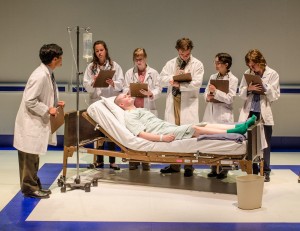“How are you feeling today?” asks Vivian Bearing in the opening monologue of “Wit.” “I have been asked as I was emerging from a four-hour operation with a tube in every orifice, ‘How are you feeling today?’” The pain and indifference Vivian must undergo are foregrounded from these first lines.
Margaret Edson’s “Wit,” directed by Craig Quintero, Theatre and Dance, brings a grim tale to Flanagan Studio Theatre this weekend. The one-act, one-set play displays a struggle with the inevitable, as the protagonist, who is battling cancer, is forced to confront the entirety of her life now that death is approaching.
The cast features Kate Loftur-Thun ’14 as Vivian Bearing, Samuel Palca ’16 as Jason Posner, Milton D. Garcia ’14 as Dr. Kelekian/Mr Bearing, Michelle Risacher ’17 as Susie Monahan, Lauren Sheely ’14 as E.M. Ashford, and Destini Powell ’17, Halley Freger ’17, Sandy Barnard ’17 and Mollie Jo Blahunka ’17 as ensemble.
The play centers on Vivian, a harsh English professor and dedicated scholar who has been diagnosed with ovarian cancer. The story alternates between interactions with Vivian and her doctors, who are more absorbed with the research possibilities of their new treatment methods than they are with their patient and Vivian’s own intellectual ruminations as she examines her life, relationships and, most importantly, her obsession with the work of John Donne, a late 16th-early 17th century English poet.
Donne’s “Holy Sonnets” play a critical role in the play—as Vivian explains, the sonnets concern life, death and God, and are defined by the most important human faculty: “wit.” As her own death nears, however, Vivian’s preoccupation with the mind struggles to fight back her fear about what is happening to her body.
“Wit” is a starkly realistic work. In order to capture the details of life experienced by cancer patients, a number of community members were consulted. Assistant Director of Service Learning and Engagement Susan Sanning organized visits by hospice workers and a tour of the Grinnell Regional Medical Center’s radiology unit. James Lee, English, gave a short talk about the writings of John Donne. Karla Erickson, Sociology, provided a list of readings about end-of-life care. There is a sense of precision and detail evoked by the set created by Justin Thomas, Theatre and Dance: a bone-white hospital room, with IV tubes and charts brought in and out as Vivian finds herself at the center of a medical circus. The ensemble effectively portrays the various doctors and nurses, employing the play’s dense medical language to create a credible air of anatomical coldness surrounding Vivian’s decline.
“In rehearsals, we focused a lot on ‘not acting,’” Quintero said. “Although this might seem like odd instructions to give an actor, I believe this perspective is essential. Our intention is not to stage a show as much as it is to share an honest experience. I am interested in theatre that pulls you under and holds you there, that leaves you gasping for air.”
Vivian, played by Loftur-Thun, is naturally the emotional core of the play. In order to capture the distress of her character’s imminent death, Loftur-Thun prepared extensively for the role.
“I used a combination of character exercises in rehearsal, independent research and a lot of time spent thinking about dying alone. It wasn’t always a very pleasant process,” Loftur-Thun said. “There was one rehearsal in particular that involved thinking about dying and then watching videos of cancer patients. It was really rough.”
Loftur-Thun’s dedication—she even went as far as shaving her head for the role—drives the play every second she is on stage. She plays Vivian with steely anxiety as she alternates between grandiose rants and snarky metafictional asides, always glimpsing the knowledge of what is happening to her without ever fully confronting it.
Vivian’s tragedy is that, while she can understand poetry quite well, she can never fully understand death. Unlike poetry, death has no drama, resolution or agency. It simply is, without ceremony or prejudice; it is utterly indifferent.
The horror of this realization is only lessened by the way the supporting characters are written. They appear to have no existence independent of Vivian—mostly coming on stage through improbable coincidences to give closure to Vivian’s scenes, or, when she is unconscious, simply repeating the mind-body dualisms that torment her. As a result, the play slightly flounders towards the end, when Vivian is in the final grips of her illness.
Despite these shaky moments, “Wit” overall is a powerful, haunting drama. Vivian’s overly-intellectual character transcends mere stereotype and verges on profundity. In showing Vivian’s passions and obsessions from a young age, the play suggests that Vivian’s search to find meaning in poetry has always been about fleeing the answers rather than confronting them and that with death she has finally been cornered with no chance of escape.
There will be performances of “Wit” tonight and Saturday at 7:30 p.m. and on Sunday at 2 p.m.

Doctors disinterestedly surround protagonist Vivian (Kate Loftur-Thun ’14) on her death bed. Photo by Shadman Asif.

































































